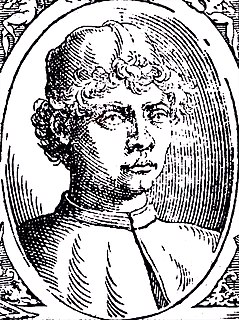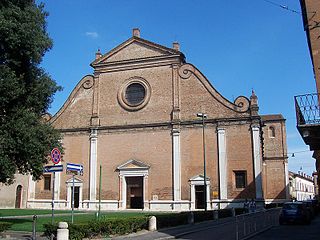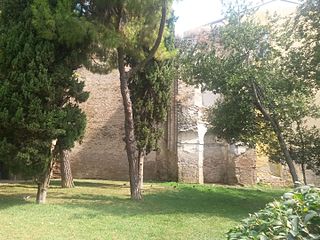Related Research Articles

Rimini is a city in the Emilia-Romagna region of northern Italy and capital city of the Province of Rimini. It sprawls along the Adriatic Sea, on the coast between the rivers Marecchia and Ausa. It is one of the most notable seaside resorts in Europe with revenue from both internal and international tourism forming a significant portion of the city's economy. The first bathing establishment opened in 1843. Rimini is an art city with ancient Roman and Renaissance monuments, and is also the birthplace of the famous film director Federico Fellini.

Piero della Francesca, originally named Piero di Benedetto, was an Italian painter of the Early Renaissance. To contemporaries he was also known as a mathematician and geometer. Nowadays Piero della Francesca is chiefly appreciated for his art. His painting is characterized by its serene humanism, its use of geometric forms and perspective. His most famous work is the cycle of frescoes The History of the True Cross in the church of San Francesco in the Tuscan town of Arezzo.

Benozzo Gozzoli was an Italian Renaissance painter from Florence. A pupil of Fra Angelico, Gozzoli is best known for a series of murals in the Magi Chapel of the Palazzo Medici-Riccardi, depicting festive, vibrant processions with fine attention to detail and a pronounced International Gothic influence. The chapel's fresco cycle reveals a new Renaissance interest in nature with its realistic depiction of landscapes and vivid human portraits. Gozzoli is considered one of the most prolific fresco painters of his generation. While he was mainly active in Tuscany, he also worked in Umbria and Rome.

Sant'Anna dei Lombardi,, and also known as Santa Maria di Monte Oliveto, is an ancient church and convent located in piazza Monteoliveto in central Naples, Italy. Across Monteoliveto street from the Fountain in the square is the Renaissance palace of Orsini di Gravina.
Antonia Malatesta of Cesena, also known as Antonia Malatesta of Rimini, was a Duchess of Milan by marriage to Giovanni Maria Visconti. She was the Regent of Milan in the interrim after the death of her spouse in 1412.

San Domenico is a Roman Catholic basilica church, located on Piazza Giordano Bruno and via del Castellano in the city of Perugia, region of Umbria, central Italy.
Francesco Migliori, also known as Francesco Megliori was an Italian painter of the Baroque period, active mainly in his native Republic of Venice.
Adeodato Malatesta was an Italian painter, trained in a grand Neoclassical style, depicting mostly of sacred and historic subjects.

The San Pietro Polyptych is a polyptych by Italian Renaissance master Perugino, painted around 1496–1500. The panels are now in different locations: the lunette and the central panel, depicting the Ascension of Christ, are in the Museum of Fine Arts of Lyon, France.

San Giuliano or San Giuliano Martire is a Renaissance-style Roman Catholic church in Rimini, Italy.

San Francesco is a late-Renaissance, Roman Catholic minor basilica church located on via Terranuova in Ferrara, region of Emilia-Romagna, Italy.

San Francesco Saverio also known as the Church of the Suffragio is a Baroque-style Roman Catholic church located in Piazza Ferrari #12 in Rimini, Italy.

Sant'Agostino is a Romanesque-Gothic-style Roman Catholic church located in Via Cairoli in Rimini, Italy. It is one of the older extant church buildings in Rimini.

San Bernardino or San Bernardino da Siena is a Baroque-style Roman Catholic church located in vicolo San Bernardino #26 in Rimini, Italy. The church and adjacent convent are now affiliated with Clarissan Order nuns.
San Giovanni Battista is a Baroque-style Roman Catholic church located on Via XX settembre #1870 in Rimini, region of Emilia-Romagna, Italy.

The Chiesa dei Teatini or the church of the Theatines, was a Baroque-style Roman Catholic church located in Rimini, region of Emilia-Romagna, Italy. The church was destroyed during the fierce bombardments preceding the Battle of Rimini in 1944, and only ruins of the interior of the apse remain in a park where the church once stood. A plaque recalls the former church.
Santa Chiara also known as the Santuario Madonna della Misericordia or Sanctuary of the Mater Misericordia is a Baroque-style Roman Catholic church located in via Santa Chiara #28 in Rimini, Italy. The church is best known for housing a venerated icon of the Madonna that has putatively moved its eyes for many believers.

San Bartolomeo, also known as the Santi Bartolomeo e Marino or Santa Rita, is a Baroque-style Roman Catholic church located in Rimini, region of Emilia-Romagna, Italy.
The Museo della Città is the civic museum located in the former Jesuit convent on Via Luigi Tonini #1 of the city of Rimini, in the region of Emilia-Romagna, Italy. It rises adjacent to Chiesa del Suffragio, and a modern structure built to enclose the ruins of an ancient Roman Domus, or house.

The Porto San Giorgio Altarpiece or Porto San Giorgio Polytpych was a 1470 multi-panel tempera and gold on panel altarpiece by Carlo Crivelli. Stylistically similar to Crivelli's Massa Fermana Altarpiece, the work was a fundamental step in his evolution away from the Paduan Renaissance towards a more delicate and realist style.
References
- ↑ Guida del forestiere nella città di Rimini, by Luigi Tonini, 1864, page 62.
- ↑ Comune of Rimini, entry on church and abbey.
- ↑ Luigi Tonini, page 62.
- ↑ Rimini Tourism website.
| | This article about a Roman Catholic church building in Italy is a stub. You can help Wikipedia by expanding it. |